An attempt at classification (cultural, anthropological and genetic) of the mysterious population of the Guanches, ancient inhabitants of the Canaries, and a look at the Hellenic myths concerning the "Fortunate Islands" and the 'mythical' war against Atlantis
When the Spaniards in the thirteenth century landed on the Canary Islands and came into contact with its inhabitants, the Guanches, the latter were shocked: they they were in fact convinced that they were the only survivors of an ancient catastrophe that they indelibly kept in their mythical memory. They told the Spaniards that the islands that formed the archipelago, in reality, were the remains of the mountain tops that were part of an ancient land submerged by water after a violent cataclysm. Some chroniclers also report that they claimed they originally came from a large island disappeared in the ocean. It is also said that the Arabs, when they discovered the archipelago in 1016, called them Khaledat (the island that does not disappear).
Little and nothing is known about the Guanches. Apart from a few symbolic and indecipherable carvings inside the caves, they have left almost no written record of their history. The only information available was gathered by Spanish chroniclers, historians and explorers following the conquest that took place in the XNUMXth century. The Guanches went down in history as the first people to be victims of Spanish-Catholic colonialism. Physically, they were generally tall in stature—adult males had an average height of about 1,80 m—of robust and powerful build. They had white skin and, most of them, blond or red hair and blue or gray eyes. Men also wore long and thick beards.
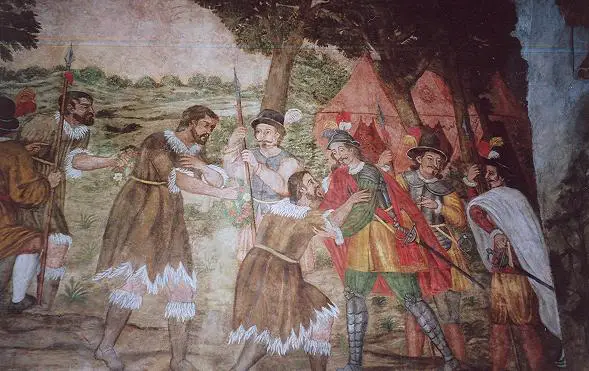
Culture and society
The Spaniards, at the moment of their arrival among the Guanches, found there a more unique than rare culture. They mostly lived in natural or artificial caves, which they decorated with abstract and geometric figures, mysterious symbols formed by spirals and triangles, similar to the European Ice Age Cro-Magnons. They dug their own architecture into the tuff, creating square colonnades carved into the rock walls. They almost remained in the Stone Age: they did not know metalworking and used stone, bone, wood, shells and terracotta tools.
Some reporters report news of self-inflicted cranial trepanations for the purpose of increasing vision perception. The ritual suicide he was considered honorable and, on the occasion of the establishment of a new leader, one of his subjects honored him voluntarily by throwing himself off a cliff: we find similar customs among the pre-Columbians.
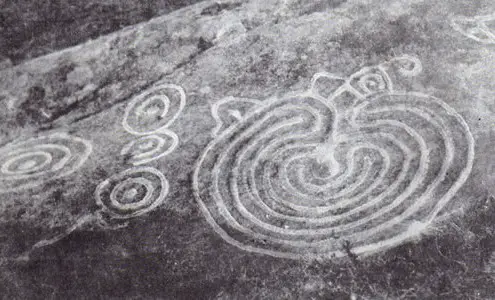
The disconcerting aspect, however, concerned the culture of these people, absurdly complex and evolved above all from a social point of view. It is known, in fact, that normally so-called 'primitive' societies do not have classes or hierarchies; the Guanches, on the contrary, they had kings, princes, nobles, dynasties, a well-organized priestly class and a warrior caste, as if it were an urban society. The hereditary transmission of kingship took place through the matrilineal way, that is, although the authority was held by the king, he inherited his dignity from his mother (for example he could be the son of the previous king's sister.
They also possessed an alphabetic script, strangely similar to the Libyan alphabet spoken in the Sahara region by the Tuareg / Berbers of Caucasian ethnicity. The Spaniards also noted that women enjoyed the same rights as men and assumed that, perhaps, in the past society cheeks was founded on a matriarchal structure, similar to that of archaic Crete or Sicily of the Goddesses. For example, a customary rule forbade a man to speak first to a woman, forcing him to wait patiently for the latter to come forward.
As for the male component of Guanche society, the names of the ancient kings and heroes who ruled before the arrival of the Spaniards and who proudly opposed their conquest for over a century are still remembered today: Tinerfe, hence the name of the island of Tenerife, Pelinor, Bencomo, Achaimo, Doramas. On the pier of the port of Tenerife you can admire the statues of the Guanche kings, called Menceyes. Curiously, at the time of the arrival of the Spaniards, the Guanche territory was divided into 10 districts, each governed by a Mencey. The parallelism with the Atlantean government as Plato tells it to us is evident; but we will have the opportunity to talk more about this later on.
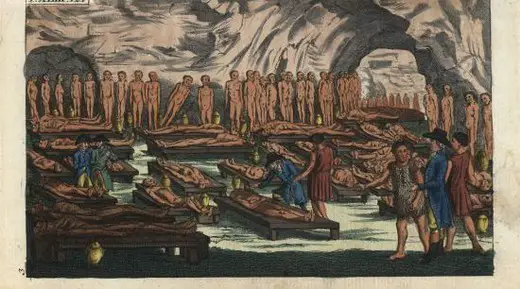
Mummification
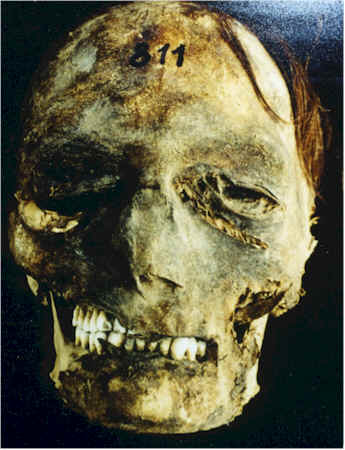
Another striking feature of the Guanches was their science of embalming the dead: in many caves or buried under burial mounds have been found—and most of the time, unfortunately, looted—countless completely dehydrated mummies, weighing no more than 6 or 7 kilograms, sometimes even under 4! The mummification practiced by the Guanches is similar to that of the ancient Egyptians: the corpse was emptied of the internal organs (which were often kept in separate containers), left to dry in the sun and wrapped in goat skins. The mummification operation was reserved for a class of professionals, who were women for women and men for men.

Pyramidal constructions
A Guimar, on the east coast of Tenerife, in the mid-80s some of them came to light during an excavation pyramidal constructions, each consisting of five rectangular lava stone steps, which strangely resemble those built in Mexico by the Maya and Aztecs and in the Middle East by the Babylonians. There were originally nine pyramids, but only six remain. They were discovered, studied and made known to the world by the work of the famous researcher and navigator Thor Heyerdahl, who pointed out that the pyramids had a precise astronomical orientation.
All the pyramids, in fact, have a staircase on the western side, climbing which it is possible to follow the path of the rising sun on the day of winter solstice. On the day of the summer solstice, however, you can witness a double sunset from the top of the highest pyramid: the sun first descends behind the top of a high mountain, passes it, appears again and then sets behind the mountain next to it. to the first. The presence of pyramids, however, was already reported in 1632 by the Franciscan friar Juan de Abreu, who also describes some of them on the island of La Palma. The chronicler also reports that these constructions were built in imitation of "a sort of natural pyramid" consisting of a single block of rock, which was called by the Guanches'Idafe', name of a mysterious deity to which it was consecrated.
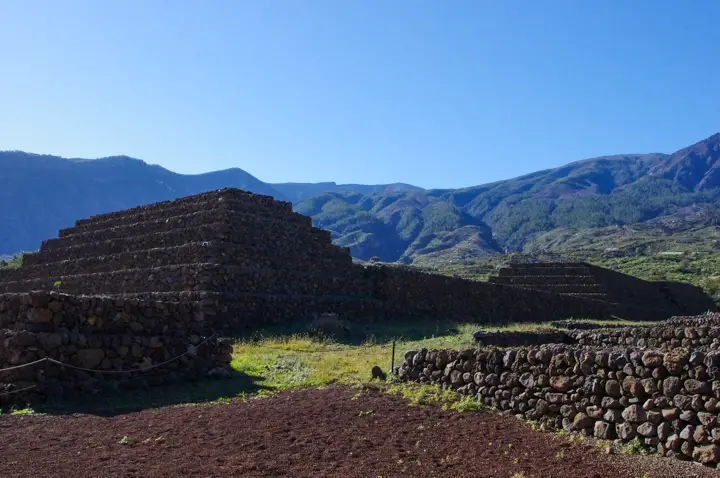
Religion
First of all they believed in a God the Creator, superior to all others, called in various ways: acoran in Gran Canaria, Achaman in Tenerife, Eraoranhan in El Hierro, Economy in La Palma, Orahan in La Gomera. Some scholars believe it can be identified with the Egyptian Amun. They also adored Magec, God of the Sun.
They also believed that the immortal soul of all men came from the Light of the Sun and was of the same substance: consequently to this belief, they thought that all men were the divine and immortal children of Magec and that, after death, they would return to his Kingdom of Light. Solar cults of this kind developed shortly before the beginning of our era throughout the Mediterranean area, and such beliefs were also alive in the ancient pre-Columbian civilizations, in Mexico as in Peru, as well as among many native populations of North America.
They also gave worship to a Great Mother Goddess they called Chaxiraxi, called the 'Mother of the Sun' and 'She who rules the world'. When, at the beginning of the XNUMXth century, they fished out a wooden statue of the Christian Madonna, probably the result of a shipwreck that occurred to a Spanish ship, immediately identified it with Chaxiraxi and worshiped it in a sort of syncretistic cult as 'Mother of the Light of the World'.
The surprises do not end there: the Spanish chroniclers discovered with bewilderment that the feast dedicated to the Great Mother Goddess (the Benesmer, which concluded the agricultural cycle of harvesting the fruits of the earth and with which at the same time the new year began) was celebrated on August 15, the date dedicated, in the Catholic calendar, to the Assumption of Mary!

The Guanches also recognized the existence of a Hell God, similar to the Christian Devil but even more to the Mediterranean Pluto / Hades, which they called Guayote. They believed that such a demon, represented in the form of a black Dog in the manner ofInpu / Anepu Egyptian (identified by the Greeks as Anubis, equivalent to the psychopomp Hermes) lived at the bottom of the Teide volcano, in Tenerife, which in legends cheeks was regarded as the door of the underworld.
These legends are very reminiscent of Icelandic, Irish and even Italic folklore, which used to identify hell near volcanoes such as Etna and Vesuvius, as well as beliefs- once again - of the pre-Columbian peoples, who located the access points to the underworld at volcanoes or underground lakes, the xenote. Guayote was thought of as accompanied by a host of underworld demons with the appearance of black, hairy dogs, named Jucanchas in Tenerife and Tibicenas in Gran Canaria. Some authors point out the surprising similarity, right from the etymological aspect, between the demon of the Guanches and Coyote, trickster of many Amerindian mythologies.
Other gods of their pantheon were Achuguayo, god of the moon and Achuhucanac, god of rain. Furthermore, a divine child son of Chaxiraxi and Achaman—Which constituted with them a trinity, as is often found in archaic religious traditions—which after the Spanish conquest was identified in the Child Jesus. The Guanches also made offerings to innumerable other minor deities and spiritual entities related to the world of nature, demons, ancestors' spirits and i Maxios, beneficial geniuses, guardians of particular places, such as mountains and springs (equivalent to genius loci Latin).
Another disconcerting correspondence with the Italo-Hellenic and pre-Columbian civilizations is found in the institution, among the Guanches, of a priestly college of nuns, who lived in a monastery where no man could come near. This sort of proto-historical Vestals were considered the 'Brides of the Sun' and their task was to always keep the sacred fire burning, symbolizing the light and eternal life brought by the God of the Sun. The similarity with the Latin cult of Vesta (and the Hellenic one of Estia), as well as with the traditions of numerous Amerindian populations (including the Natchez of southern Mississippi) is faultless.
Origin of the Guanches:
the Berber and Germanic hypotheses ...
The origin of the Guanches remained a mystery for a long time. Researchers think that the first settlers arrived in the Canary Islands around 3000 BC, coming from Africa. This seemed to be in line with the fact that their phonetic alphabet resembled that of the Berber people; for this reason, some scholars hypothesized that the Guanches were the last survivors of primitive populations of Northern Africa, perhaps of Phoenician or Carthaginian ethnicity) who in ancient times had gone to the island and had placed their settlements there.
However, the fact that the Guanches absolutely did not practice navigation to the point of not even knowing how to build a raft and never having come into contact with the populations that inhabited the neighboring islands seems to strongly contrast with this hypothesis, as well as the European ethnic characteristics of this mysterious people seems to definitively put a stone on the subject.
Scholars of the Germanic language saw in the Guanches the descendants of the Vandals who in ancient times invaded North Africa at the time of the fall of the Roman Empire. This hypothesis would have explained their appearance, not their language (in which no trace of any Germanic influence is found) nor their complete ignorance of navigation. Their language, in fact, resembled the ancient Berber language still spoken today in some regions of the Atlas and Algeria, where you can sometimes come across Berber nomads with light skin and blue eyes.
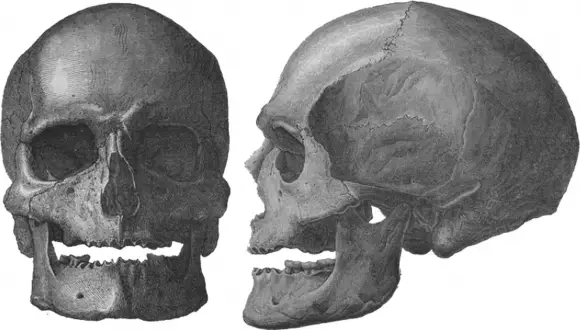
… And forensic analysis
The forensic analysis gave the solution to the enigma, by studying the shape of the skulls and analyzing the DNA of the mummies found in the catacombs inside the caves of the island. With bewilderment, it turned out that the Guanches belonged to the very ancient Cro-Magnon species which suddenly appeared in Europe about 35.000 years ago, and which populated Europe until the end of the last Ice Age. Anthropologists recognized genetic correspondences with the Basques, the Lombards, the Siberian Togar and-incredibly—With the Dakota Indians of North America, better known as the Sioux. Following these researches it was determined that, for the purpose of reconstructing the physical appearance cheeks, we should have imagined:
«A representative of the Native American tribes of North America, with a large aquiline nose and a square face, with archaic features, but with a Nordic pigmentation. "

It turned out that these populations descended from France and Spain towards the Strait of Gibraltar and populated the Sahara area, which at the time of the Ice Age was not a desert, but an immense marshy plateau called by the ancient Greek and Latin authors'Lake Tritonide'. The Mediterranean Sea, at the time, was much shallower than it is now and the Canary archipelago formed a rather large islet, divided from Egypt by the impenetrable muds of Lake Tritonide, at whose oceanic ends rose the mount Atlas. The marshy plateau that existed at the time in Western Sahara in the Greco-Roman age was called 'Tritonid lake' or 'Tritonid swamp' (Tritonias limne in Greek; Tritonis lacus o T. palus in Latin). This is the current Schott el-Jarid, a salty depression located in central Tunisia, near the city of Gafsa, now considerably smaller than in the past and, unlike then, much more arid. IS it should be noted that in the area where the current Berbers reside, at the foot of the Atlas range, geological surveys say that in the past there must have been an inland sea, each dried up, probably to be identified with the Tritonide Lake of the classical authors, named by Apollonio Rodio as the site of the shipwreck of the Argonauts.
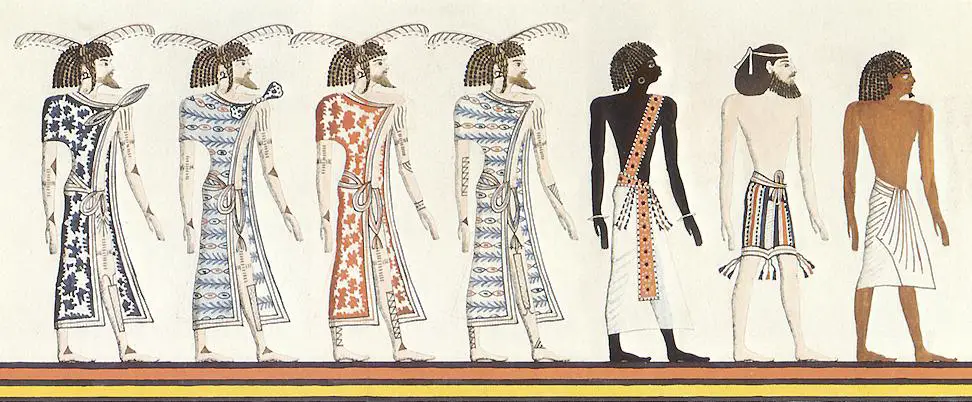
The migrations of the Cro-Magnons, over the millennia, gave birth to the breed of Guanches in the Canaries, the Cabili in Algeria and the Tuareg in the Atlas and, more generally, to the sub-race called the Atlanteans-Mediterranean. Con this recent hypothesis, it was also possible to explain the rock art of the Guanches, and its similarities with that of the Cro-Magnons, endowed with a symbolism that is often encountered among the Nordic European peoples, among the populations of the archaic Mediterranean and, surprisingly, among the Native Americans.
What we have said about the matriarchal setting of the Guanches society leads us to confirm the links with the Berber cultures, in particular that of the Tuareg, where there were (and sometimes still do) some forms of matriarchyas well as among the Proto-Indo-European peoples of the Minoan civilization. This, according to what is reported by classical historians, would also attest to an effective kinship with the Amazzoni, who according to Diodorus Siculus and other authors lived in the Libyan desert and had close relations with the Atlanteans, although often warlike.
Some have also recognized this link in the name by which the Berbers of Morocco and Algeria refer to themselves: Amazigh, extremely similar to 'Amazons'. Then there are some Berber tribes of Tunisia indicated with the name of 'Sons of the Source' and 'source', in their language, it is said Attala; according to linguists, the phoneme ATL- is due to water, not only in the language of the Saharan Berbers, but even in that of the Aztecs, which name the place from which their ancestors moved in ancient times aztlan.
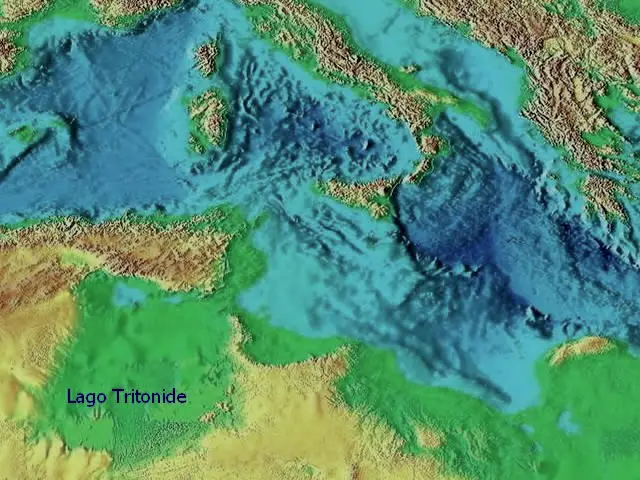
The 'Libu' and the 'Peoples of the Sea'
The ancient Egyptians claimed that they lived west of Egypt i Thousand (hence the current name of the region, Libya), their bitter enemies, with blond or red hair and blue eyes, wearing tiaras of feathers on their heads (in the same way as Native Americans, we naturally notice). In the Egyptian annals, these populations are also known under the generic name of «Peoples of the Sea», Of which it is thought they were also part the Shardana, ancient inhabitants of Sardinia, to whom the island owes its current name. Indeed, a blood relationship between Guanches and Shardana is highly probable, but all these references to the sea and navigation continue to contrast with the absolute ignorance of the Guanches on the part of the survivors at the time of the Spanish conquest.
It could be hypothesized that the "Peoples of the Sea" and the Guanches were formerly part of the same ethnic group but, while the former retained their knowledge of navigation, the latter over time found themselves isolated from the rest of the world, degenerated and forgotten.

Ancient sources and mythology:
the 'Fortunate Islands' and the 'Isola dei Beati'
Among the classical authors, it was Pliny the Elder and then Claudius Ptolemy to locate with certainty the mythical 'Fortunate Islands' with the Canary archipelago. Previously they were called 'Fortunate Islands' (Fortunatae Insulae in Latin) or "Islands of the Blessed" (makarioi nesoi in Greek). These legends on an island of the Blessed located in the far West, however, are also found in the Celtic myths of Gaul and the British Isles. They were thought to be placed beyond the 'Pillars of Hercules', or the two columns that Hercules had raised near the current Strait of Gibraltar to prevent sea monsters from entering the Mediterranean Sea.
These paradisiacal islands were sometimes considered the seat of the 'Elysian Fields': this opinion seems to be Pindar, which in the second of Olympic Odes (vv. 61-76), dedicated to Terone of Agrigento, affirms that these islands were the place destined for those who, 'having put on human spoils three times without having stained themselves with any guilt, they had made themselves worthy of eternal bliss', adding furthermore that Peleus, father of Achilles, Cadmus founder of Thebes and other heroes resided there. Diodorus Siculus (Historic Library, V, 19-20) affirms that in these islands the climate was always mild, there was no need for work because the generous land brought abundant fruit to its fortunate inhabitants. In short, it seems a reinterpretation of the myth of the Latin Golden Age ruled by Saturn. Also Hesiod, for his part, he considered it a privileged place by nature, full of spontaneous and abundant fruit, kingdom of Cronus and deserved seat of heroes. The same opinion is reported by Luciano of Samosata in his work True story.
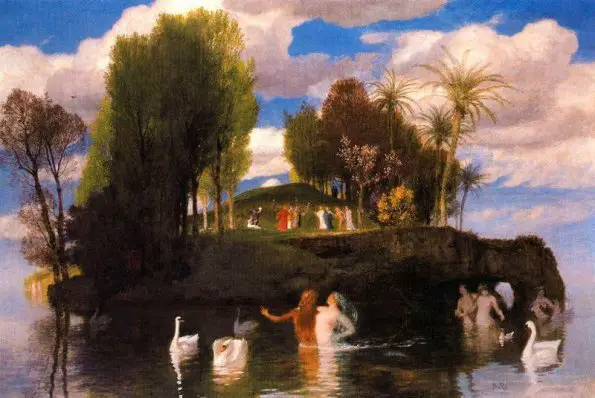
Greek mythology:
the 'Garden of the Hesperides', Atlas and the Pleiades
Furthermore, the mythical geography of the Greeks placed there the 'Garden of the Hesperides'. This garden was placed on the slopes of Mount Atlas, to the far West, where the chariot of the Sun ended its race every evening. There grew a tree with golden fruits, guarded by the will of Hera by a huge reptile, the dragon Ladone which, by rolling up to the trunk, prevented anyone from approaching. (It is perhaps curious to note how the Guanches considered the sacred Dracaena draco, a plant of the liliaceae species that survived the last ice age, under which they used to gather the Council of Nobles to administer justice.)
Another legend has it that these Seven Islands were inhabited by the Seven daughters of Atlas, the Pleiades (probably equivalent to the Hesperides of other myths) which, after spawning a lineage of giants and heroes, were assumed to heaven in the form of stars. Atlas was in turn considered the favorite son of Poseidon (the Roman Neptune), god of the sea and of earthquakes, that the myth wants to be sovereign of Atlantis, to the point that according to Plato the name of the capital of the empire (Poseidonis) derives from his. The shipwreck of the Argonauts located by Apollonio Rodio near Lake Tritonide was solved by Triton, son of Poseidon.

Ancient historical evidence:
Pliny the Elder
Pliny the Elder reports that, according to Giubia, king of Mauritania, the Carthaginians visited the archipelago around 50 BC, under the direction of the explorer Annone, and found it deserted. However, they would have found it littered with Cyclopean ruins of a vanished civilization. Regarding the Carthaginian testimony that refers to the complete absence of populations on the territory, some argue that they did not proceed to a detailed exploration of the archipelago, but only stopped on a few islands.
On the other hand, another ancient author reports that the Greeks, during their explorations, found them populated by a race of 'red satyrs', most likely an epithet used to indicate hairy red-haired people. This description of the inhabitants is perfectly in line with the physical and somatic characteristics of the last residents of the Canaries, the Guanches encountered by the Spaniards at the beginning of the XNUMXth century.
The real enigma, however, turns out to be the cyclopean remains of these ancient urban agglomerations. Since the Guanches, at the time of the Spanish conquest, did not know how to build houses with stone, it was believed that the current inhabitants were not the first inhabitants of the island. However, it is also reasonable to assume that the ancient populations suddenly found themselves isolated from the rest of the territory following a tsunami that caused the island to sink, except for the highest mountain peaks, on which sporadic and degenerate groups of the ancient Atlantic peoples survived. . The atavistic trauma of the cataclysm would do the rest, keeping them away from the ocean and navigation for millennia.

Between history and myth:
Plato and the sinking of Atlantis
Some scholars trace the tsunami to 9.000 years before Plato (mid-XNUMXst millennium BC), referring to story about the sinking of Atlantis, told by an Egyptian priest from Sais to Solon around 600 BC and reported in Timaeus. From the story it is noted that "Atlantis was an immense island, located in the Ocean opposite the Pillars of Hercules and the Atlanteans would have been a race of demigods who, degenerating from their celestial origin, corrupted themselves by mixing with the daughters of mortals , so that Jupiter punished them by destroying their race and country "(De Sanctis / Mangelli, Primitives, religion, magic and occult powers, 1935, p. 339).
We are reminded of the Greek myth of the Pleiades, which "after spawning a lineage of giants and heroes, they were taken up in the sky in the form of stars ». The realm of the Atlanteans appears to have extended as far as North Africa and Egypt which would be their colony and that one would find in the ancient papyri some affirmations confirming this millenary lineage and the name of Routes [coming from the Brahmin tradition], which means red men, with which name the Egyptians indicated the inhabitants of the submerged continents, would confirm this.
Solon further states that the sinking of Atlantis occurred during the war between the Atlanteans, ruled by Poseidon, and the Greeks. Cecrops, the first mythical king of Athens, asked for help from Athena and with his help he was able to repel the attacks. The Atlanteans perished in the cataclysm in a single night and the people of Cecrops honored Athena by renaming their capital in her honor. Could this be the true story behind the myth of the struggle between Poseidon and Athena for dominion over Athens?
Athen, however, is reported by many authors as queen of the Amazons, and an Amazon herself. The ancient peoples of Western Sahara worshiped a goddess called Aten, who according to Herodotus lived in the Tritonid swamp. The Tuareg (who call themselves Amazighs) and who have shown off a more or less matriarchal civilization, could therefore be the descendants of those 'Amazons' who fought alongside the Greeks against the Atlanteans (the Egyptian 'Peoples of the Sea'), over 11.000 years ago in the Mediterranean Sea.
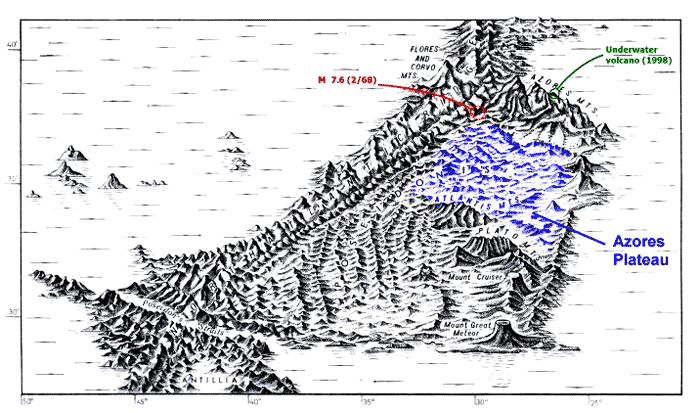
Some scholars argue that the 9.000 years of which Plato speaks are to be considered—Not as solar years, but-how lunar years, therefore as months. Following this theory, they affirm that the cataclysm that caused the sinking of Atlantis and the division of the islet into an archipelago formed by seven islets, as well as the drying up of the Tritonid Sea and the formation of Western Sahara as we know it today (ie desert), occurred about 725 years before Plato, or 1.300 years before our era. It would therefore be related to the volcanic eruption of Thera (today's Santorini) which, among other things, would also have caused the submersion of other territories in the Mediterranean, considerably resizing the island of Crete (on which a culture with many points of contact with the Guanches resided) and isolating Malta.
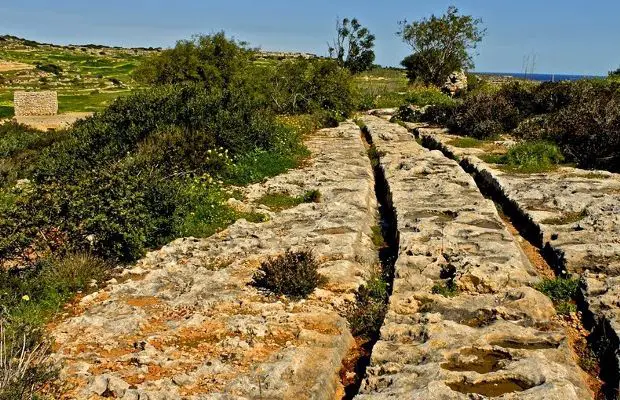
In this regard, we mention the very mysterious 'stone tracks' present on the island, which often do not lead anywhere but end up in the open sea. Their age and purpose is still a mystery: scholars generally assume that the furrows date back to 2000 BC, when the first settlers from Sicily or Crete arrived to start the Bronze Age on Malta. But nothing prevents us from thinking that they are even older, with an age estimated by some to be over 10.000 years ago. Similarly, some scholars trace the construction of the equally mysterious ones underground hypogea present on the island in inconceivable eras for academic history.
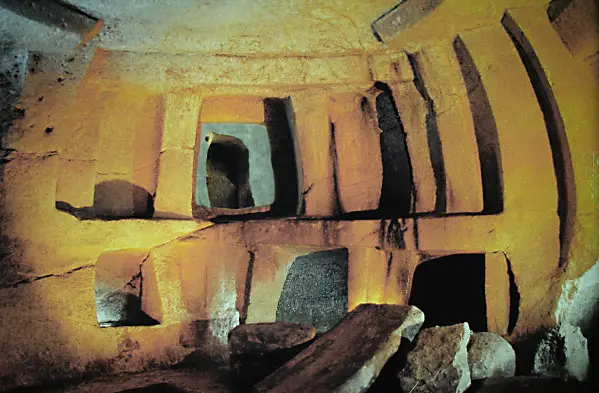
But the thesis that traces the sinking of Atlantis back to 9.500 years before our era seems to be more in line with tradition. Proclus, eg, tells us that Atlantis was made up of seven islands among which it seems there were also the current Canaries (or rather, the emerged land that once included the entire archipelago) and that the largest of them, called Poseidonis named after the ruler of the kingdom, it still existed eleven thousand years before our era. The Indian tradition calculates that the submersion occurred eleven thousand years before our era and is therefore in perfect agreement with the Greek tradition.
According to many ancient traditions, the partially submerged island eleven thousand years ago (the current Canary Islands) was only a part of the original Atlantis, while the continent itself, much larger, would have sunk in much earlier times. The eruption of Thera (today's island of Santorini), much more recent, would have definitively sank the last territories inhabited by the descendants of the Atlanteans, including those belonging to the Minoan-Cretan civilization.
The current Berbers of the Atlas range in North Africa would be among the last survivors of that ancient lineage that the Greek historians called 'Amazons', formerly related to that of the 'Peoples of the Sea', but later came to arms with them. Even today the Tuareg dress in blue and over time their skin, in close contact with the turquoise pigmentation of the clothes, takes on the same color. Their legends want them to be descendants of the Atlanteans.
In this context, the Guanches would be of the same original ethnic line (that of the proto-Indo-European Cro-Magnons, later subdivided into 'Peoples of the Sea' or Atlantides, Minoans, Amazons and more recently Berbers and Tuareg) but would have remained isolated from other populations following the cataclysm dated 9.500 before our era. The only ones who were saved from the sinking of the original Canarian territory were the few isolated groups on the peaks of the mountains. Perhaps for this very reason the Guanches always remained in the Stone Age and never knew navigation.
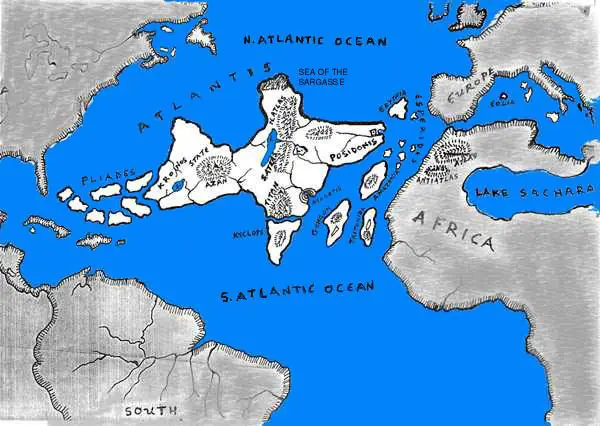
Online insights:
- http://www.cunpugliabasilicata.it/articoli/curiosit-misteri-delle-isole-canarie-parte-ii/
- http://www.cunpugliabasilicata.it/articoli/curiosit-misteri-delle-isole-canarie-parte-iii/
- http://www.cunpugliabasilicata.it/articoli/curiosit-misteri-delle-isole-canarie-parte-iv/
- http://www.cunpugliabasilicata.it/articoli/curiosit-misteri-delle-isole-canarie-parte-ed-ultima/
- http://loasiditammuz.altervista.org/le-amazzoni-ad-atlantide-seconda-parte/
- http://loasiditammuz.altervista.org/le-amazzoni-ad-atlantide-quarta-parte/
- http://www.acam.it/la-fine-di-atlantide/
- http://www.ilcorrieredelleregioni.it/index.php?option=com_content&view=article&id=902:popoli-misteriosiqgli-aborigeni-delle-isole-canarieq&catid=71:altre-religioni&Itemid=97
- http://www.ormedineve.com/reader_det.asp?s_art_id=578
- http://www.ilnavigatorecurioso.it/2014/05/19/lenigma-dei-guanci-i-discendenti-dei-sopravvissuti-di-atlantide/
- http://paranormaltour.blogspot.it/2013/02/il-mistero-dei-guanci.html
- http://blog.libero.it/Terpetrus/9456342.html
- http://blog.libero.it/Terpetrus/9456356.html
- http://www.vacanzeallecanarie.com/Home/tenerife/storia-di-tenerife/guanci/segreto-dei-guanci
- http://www.vacanzeallecanarie.com/informazioni-su-tenerife-storia-luoghi-spiagge-e-molto-altro/piramidi-guimar
- http://www.isolecanarie.com/tag/popolazione-dei-guanci/

Beautiful, in particular Plato's analysis of Atlantis, it would be nice to read other insights about it and maybe even have a pdf version for easier reading, if you like it, come and read my articles on Plato's Hyperuranium. https://hokmaph-iperuranio.blogspot.it/2015/09/articoli-iperuranio-mondo-delle-idee.html
Interesting article! However, I must point out that the culture you explain is that of Tenerife, mainly… 1 of the 7 islands. As you have pointed out, the aborigines did not sail, so they had no contact with each other. Although the origin was the same, the organization was different on each island. Sorry for my Italian .... thanks anyway for bringing the ancient Canarian culture to Italy
Thanks to you for your interest 🙂
Excellent treatment of the topic with coherent illustrations.